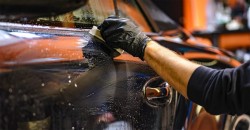Subaru Fuel Line Diagram: Understanding Your Car's Fuel System
Understanding the fuel line system of your Subaru is important for carrying out tasks that relate to this car system. You may need to replace your entire fuel line which is something that can be done at home, but with a Subaru fuel line diagram, you can easily assemble the new components of your fuel line without any hassle.
This article takes you on a full guide to understanding your car’s fuel system. We define what a fuel line is, its working mechanism, the materials that can be used to construct it, and how it can be mounted.
What is a fuel line?
A fuel line can be a cylindrical pipe or hose that is used to transport fuel to the appropriate places in your car system. The transportation of fuel is usually done from the storage unit to the combustion chamber where it is used to generate power for movement.
A fuel line can be made of various materials, but it is usually made of reinforced plastic to prevent physical impact and environmental elements from breaking or kinking it. This system is positioned rather lower in your car and is often exposed to moisture, heat, humility, and other environmental factors, however, it doesn’t get damaged easily as a result of its construction material.
Fuel line systems extend beyond this definition as they hold and protect both liquid and vapor fuel. This implies that your fuel line system includes lines for filler necks, connecting the carbon canister to the fuel tank, and linking dual fuel tanks.
Fuel line materials
Like some car components, the fuel line can be made of various materials. These materials determine how long your fuel line will last and how easily affected they are by physical and environmental factors. Here are some materials that can be used to make your Subaru’s fuel line system.
Rubber fuel line hose
Rubber hoses are used to connect the fuel pipe of your car’s chassis to the carburetor or fuel pump. This material is flexible and allows you to cut or shape it to any length you want, however, if not correctly installed they become less abrasive. Generally, rubber fuel lines don’t last as long as other materials.
Steel fuel line
Steel pipes usually connect the chassis or fuel tank to the engine bay and they are common in front-wheel drives and rear-wheel drives. This material while strong may cause many complications with the presence of heat. Without insulation, it may corrode, and due to heat from the engine, your car may experience vapor lock and the fuel line may conduct some heat which can be hazardous.
Copper fuel line
Fuel lines made of copper are durable but not as strong as steel and they quickly corrode due to environmental factors. Copper is less expensive than stainless steel making it a great material for people on a budget, however, stainless steel has proven to be a better metal alternative.
Nylon fuel line
Nylon hoses are getting increasingly popular with recent car models. They are used to connect fuel feed lines to fuel pump modules. When compared to rubber lines, nylon lines do not degrade and get brittle, especially when paired with nylon barbs.
Subaru Fuel Line Diagram: Understanding Your Car's Fuel System
The basic function of your fuel system is to store and deliver the gasoline or diesel you fuel needs for power, and this system includes the fuel tank, fuel pump, fuel line, fuel filter, and fuel injectors. When you visit a gas station to get some fuel, the fuel travels through the filler down to the fuel tank for storage, this tank houses emission control to prevent air pollution. The fuel pump which is attached to your car’s engine sends fuel from the fuel tank to the engine which uses the car’s motion to effectively pump fuel.
Paired with this Subaru fuel line diagram, this description should show you how your car’s fuel system works.
The fuel from the fuel pump makes a first stop at the fuel filter through the fuel line. The fuel filter removes dirt and debris to prevent them from clogging the fuel injector and carburetor. If your fuel filter is clogged or dirty, it will not effectively filter the fuel and this can damage your car’s fuel system.
After passing through the filter, the fuel is taken to the engine where the fuel injector injects it into the combustion chamber. Before fuel injectors, carburetors were initially used to measure the appropriate quantity of air needed to react with fuel for combustion, but this system was lacking in terms of combustion at different RPMs. With fuel injectors, energy can continuously be supplied to the combustion chamber.
Fuel line maintenance
Regardless of the material you choose for your fuel line, improper maintenance techniques can damage your Subaru’s fuel system and your car. Here are some maintenance tips to keep your fuel system in a good state.
Inspection
After changing or replacing your fuel line, it is important to inspect every connection and ensure they are connected correctly, check the hoses for leaks or breaks, and inspect vulnerable spots for possible damages. This can help you prevent a car issue before it occurs.
Fuel induction service
Your car engine does a lot of work to keep your car moving and with time, the ethanol contained in your fuel can cause a build-up of carbon which can clog some components of your fuel system and interrupt the combustion process. Your car will act unusual when this happens and you can observe this with some common symptoms like trouble starting your car, idling, and other ignition problems.
Fuel induction cleans out various components of your fuel system like your injector and intake valves, and this improves fuel mileage and the overall performance of your car. This service is gotten after your car has run for 30,000 miles and it is carried out by inserting a fuel drier into the tank to soak up any moisture and then using a fuel cleaner to get rid of any carbon buildup. Finally, an air intake cleaner is used to clean up the manifold and valves which are related to the fuel system. There are several cleaners and additives to back up this cleaner that you can purchase for your Subaru. These cleaners not only help your fuel system but your combustion system as well.
The fuel system is one basic component of the car as it is needed to be fully functioning for your car to be used properly. This article highlights the key components of a Subaru fuel system and their functions, the materials that can be used to make the fuel lines, and how the fuel system works.
It is essential to handle the fuel system with care and occasionally inspect it for any potential damage. As for the maintenance process, it is also essential to keep this section of the car clean and this is achieved using a fuel cleaner and the proper additives. The Subaru fuel line diagram shows you the connection of the various components in this vehicle, this should guide you on disassembling and installing your fuel lines.
Conclusion
The fuel system is one basic component of the car as it is needed to be fully functioning for your car to be used properly. This article highlights the key components of a Subaru fuel system and their functions, the materials that can be used to make the fuel lines, and how the fuel system works.
It is essential to handle the fuel system with care and occasionally inspect it for any potential damage. As for the maintenance process, it is also essential to keep this section of the car clean and this is achieved using a fuel cleaner and the proper additives. The Subaru fuel line diagram shows you the connection of the various components in this vehicle, this should guide you on disassembling and installing your fuel lines.



